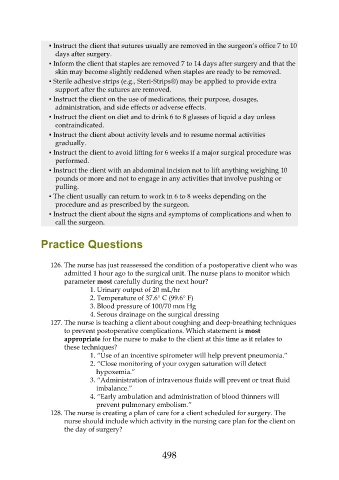Page 498 - Saunders Comprehensive Review For NCLEX-RN
P. 498
▪ Instruct the client that sutures usually are removed in the surgeon’s office 7 to 10
days after surgery.
▪ Inform the client that staples are removed 7 to 14 days after surgery and that the
skin may become slightly reddened when staples are ready to be removed.
▪ Sterile adhesive strips (e.g., Steri-Strips®) may be applied to provide extra
support after the sutures are removed.
▪ Instruct the client on the use of medications, their purpose, dosages,
administration, and side effects or adverse effects.
▪ Instruct the client on diet and to drink 6 to 8 glasses of liquid a day unless
contraindicated.
▪ Instruct the client about activity levels and to resume normal activities
gradually.
▪ Instruct the client to avoid lifting for 6 weeks if a major surgical procedure was
performed.
▪ Instruct the client with an abdominal incision not to lift anything weighing 10
pounds or more and not to engage in any activities that involve pushing or
pulling.
▪ The client usually can return to work in 6 to 8 weeks depending on the
procedure and as prescribed by the surgeon.
▪ Instruct the client about the signs and symptoms of complications and when to
call the surgeon.
Practice Questions
126. The nurse has just reassessed the condition of a postoperative client who was
admitted 1 hour ago to the surgical unit. The nurse plans to monitor which
parameter most carefully during the next hour?
1. Urinary output of 20 mL/hr
2. Temperature of 37.6° C (99.6° F)
3. Blood pressure of 100/70 mm Hg
4. Serous drainage on the surgical dressing
127. The nurse is teaching a client about coughing and deep-breathing techniques
to prevent postoperative complications. Which statement is most
appropriate for the nurse to make to the client at this time as it relates to
these techniques?
1. “Use of an incentive spirometer will help prevent pneumonia.”
2. “Close monitoring of your oxygen saturation will detect
hypoxemia.”
3. “Administration of intravenous fluids will prevent or treat fluid
imbalance.”
4. “Early ambulation and administration of blood thinners will
prevent pulmonary embolism.”
128. The nurse is creating a plan of care for a client scheduled for surgery. The
nurse should include which activity in the nursing care plan for the client on
the day of surgery?
498

